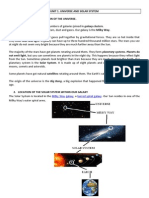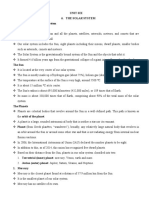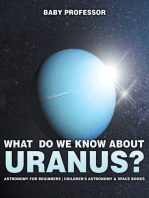The Evening Sky Map: JANUARY 2014
The Evening Sky Map: JANUARY 2014
Uploaded by
3582Copyright:
Available Formats
The Evening Sky Map: JANUARY 2014
The Evening Sky Map: JANUARY 2014
Uploaded by
3582Original Title
Copyright
Available Formats
Share this document
Did you find this document useful?
Is this content inappropriate?
Copyright:
Available Formats
The Evening Sky Map: JANUARY 2014
The Evening Sky Map: JANUARY 2014
Uploaded by
3582Copyright:
Available Formats
R
Ly
r
Big
es
The per
t
e
Dip
J E a re
Ve
ar AR
g
C
r
x
a
T
e
E
tam
S
qu
ll u
AP
A
Thuban
i
i
n
r
Po Y M
R
e
E
d
K
nd
L
t
O
o
r a HE S
C
s
A
e
T
e
T
st o
E
i
D
Ca
RN
B E t.
TU
Mizar
T
W
E
) .
Alcor
E
&
N
R TH
T
Fro
HE
NO
m
Z
E
n
LE
N
o
r
I
t
TH
MP
h
e
r
n
A
CP).
EXA
la
N
NORTH
t
D
i
t
le ( N
u
F OR
TH
de
s
al P o
,
E
s
LE (
t
H
a
rs
O
C e le s ti
a
p
R
p
e
C IR C
I
a
r
Z
t
o
rotate around the North
ON . C
R IZ O N
OMPAS
THE HO
S DIRECTIO
NS ARE INDICATED ALONG
i
sk
k
ar
OB
D
L
.
AR y (
IA
xy
M3
Enif
T
S
a
l
S
M15
ON
1)
NUS
g a ELE
PHI
w
CE
C
72
me
DEL
RT i t h y
93
h o Z O N.
7
AQU
AI
2
r
o
M
u
ur
ARI
ND
o
RI
US
eye
is
AT
HO
s?
p)
ES
It i
m a S TH E
AN
n
M2
s
o
I
DT
ag
d
a la x
IME
C LE
ban
y 2.
CIR
S. T
h azy
5 mi
HE
T ER
ay (
U
W
WEST
ll i o n
O
CE N
y
k
il
lig h t y
HE
TE R
The M
e ar s a w a y
ND T
OF T
!
HE M
T H) A
AP IS T
( ZE N I
D
A
E
HE PART OF
H
R
THE SKY DIRECTLY OVE
SKY MAP SHOWS HOW
THE NIGHT SKY LOOKS
EARLY JAN 8 PM
LATE JAN
7 PM
o
ire
Alb
S
U
De
9
61
M3
CASSIOPEIA
EL
OP
AR
DA
LI
Dou
Clus ble
ter
DR
AN
M33
CE
ES
le
Hyades
IS
Ci
rc
69
e
eus
N
elg
IO
R
224
Bet
Cr
bara
G re
a
of t S q u
Pe g
a
a s u re
s
OM
ED
PEGASUS
M31
go
l
Al
ARI
22
32
M4
Mira
ius
Sir
Ri
ge
l
CE
TU
LE
P
U
a
hd
Dip
Symbols
FORNAX
AP
ERIDANUS
Galaxy
Double
Star
R
TO
e
Variable Star
LP
m
U
o
SC
dr
IT
Diffuse Nebula
A n AS
he ON
t
e
Planetary
Nebula
Z
I
e
u s HOR
yo
Open
Star
Cluster
O
n
T
C a ONGlobular Star Cluster
RI Z
HO
W
3
25
lax
CA
M1
US
Ga
S
EU
P
CE
M38
M35
2264
l
ma
Ha
Pleiades
UR
SKY MAP DRAWN FOR
A LATITUDE OF 40
NORTH AND IS
SUITABLE FOR
LATITUDES UP
TO 15 NORTH
OR SOUTH
OF THIS
PE
Polaris
AURIGA
PERSEUS
Help support the production and free distribution of The Evening Sky Map
b
ne
M81
M82
Cap
ella
M36
M37
Alde
.
TH
ES
Star Charts & Astro Posters
Telescopes & Binoculars
NCP
LY
NX
GEMINI
ite
M4
NG
S TA
RT
CY
E N
O
URSA
TH
Little M I N O R
Dipper
LY
ARI
AC
U
M R
A SA
JO
R
POL
Casto
r
Pollux
RO
SI
SAVE ON RECOMMENDED PRODUCTS http://Skymaps.com/store
Star Atlases & Planispheres
Books for Sky Watchers
TO
TA
CE
M5
More sky events and links at http://Skymaps.com/skycalendar/
All times in Universal Time (UT). (USA Eastern Standard Time = UT 5 hours.)
NO
30
31
Jup
MO
26
29
30
CANIS
MINOR
16
17
19
23
23
24
25
M44
11
12
15
16
e
S
Procyon
th
CANCER
I
N
R
as E. B
CA JO
wn FAC
A
o
M
U
7
kn
M4
is T YO
at
A
wh
TH
M67
M46
orm TION
tf
EC
eas
DI R
th M48
s ou
HE
ST
th e
EA
in
li n e
SAM
EAST
in a
THE
tars
P IS
ri g h t s
E MA
T he th re e b
C OM P
OF TH
ASS DI
OTTOM
RECTION TH
AT APPEARS ALONG THE B
8
11
SO T
HE
JANUARY 2014
New Moon at 11:14 UT. Start of lunation 1126.
Moon at perigee (closest to Earth) at 21h UT (356,923 km;
angular size 33.5').
Moon near Venus (15 from Sun, evening sky) at 11h UT. Mag. 4.3.
Quadrantid Meteor Shower peaks at 19h UT. Active
between December 28 and January 12. Produces up to 120
meteors per hour. Radiant is in northern Botes.
Earth at Perihelion (closest to Sun) at 12h UT. The
Sun-Earth distance is 0.983335 a.u. or 147.1 million
kilometers.
Jupiter at opposition at 21h UT. Best time to observe
EC
LI
the largest planet in the solar system. Mag. 2.7.
PT
IC
First Quarter Moon at 3:39 UT.
Venus at inferior conjunction with the Sun at
12h UT. The planet passes into the morning sky.
Moon near the Pleiades (evening sky) at 12h UT.
Moon near Aldebaran (evening sky) at 9h UT.
Moon near Jupiter (evening sky) at 5h UT. Mag. 2.7.
Moon at apogee (farthest from Earth) at 2h UT
(distance 406,532 km; angular size 29.4').
Full Moon at 4:52 UT.
Moon near Beehive Cluster (morning sky) at 4h UT.
Moon near Regulus (morning sky) at 2h UT.
Moon near Mars (morning sky) at 4h UT. Mag. +0.4.
Moon near Spica (morning sky) at 10h UT.
Last Quarter Moon at 5:20 UT.
Moon very near Saturn (73 from Sun, morning sky) at
14h UT. Mag. +0.6. Occultation visible along a path
between New Zealand and southern South America.
Moon near Antares (morning sky) at 19h UT.
Moon near Venus (26 from Sun, morning sky) at 3h UT. Mag. 4.5.
Moon at perigee (closest to Earth) at 10h UT (357,080 km;
angular size 33.5').
B
EG elt o
New Moon at 21:39 UT. Start of lunation 1127.
IN
fO
Mercury at greatest elongation, 18 E of Sun (evening sky) at 10h UT. Mag. 0.5. BY U rion
NORTHERN HEMISPHERE
2
3
he
OU tw in
N
s
D
o
ns
IT
S
CE of L e
NT
d
E
R ( a in
c
JU
ST l assic
al
A
S
m
YO
U A yt h ol
ogy
RE
.
D
OIN
GN
O W)
1
1
Get Sky Calendar on Twitter
http://twitter.com/skymaps
DR
Sky Calendar January 2014
CO
FREE* EACH MONTH FOR YOU TO EXPLORE, LEARN & ENJOY THE NIGHT SKY
KY
S.
da
The Evening Sky Map
.S
W
AP
KY
MA
P T Th e P
M
leia
OF
.
des
I ND
F RO
rby
, or
nea
SKY
AB
e
r
S
T
a
e
H
RIG
ve n
IG
SOUTH
a de s
-1 0
1
2
3
4
S ist e
HT S
RE N
r s, a r e
ed H y
TAR
V -s h a p
e a si ly s e e n
E NT I
PATT
with the naked eye. The
THE
E RN I
S
Copyright
20002014
Kym
Thalassoudis.
All
Rights
Reserved.
W
N THE S
AP SHO
KY.
INSTRUCTIONS: THE SKY M
* TERMS OF USE: FREE FOR NON-COMMERCIAL EDUCATIONAL USE. ASTRONOMY EDUCATION GROUPS
Star Magnitudes
MAY FREELY DISTRIBUTE PRINTED HANDOUTS. FULL DETAILS AT http://Skymaps.com/terms.html
Tips for Observing the Night Sky
When observing the night sky, and in particular deep-sky objects such as star clusters,
nebulae, and galaxies, its always best to observe from a dark location. Avoid direct
light from street lights and other sources. If possible observe from a dark location
away from the light pollution that surrounds many of todays large cities.
You will see more stars after your eyes adapt to the darknessusually about 10 to
20 minutes after you go outside. Also, if you need to use a torch to view the sky
map, cover the light bulb with red cellophane. This will preserve your dark vision.
Finally, even though the Moon is one of the most stunning objects to view
through a telescope, its light is so bright that it brightens the sky and makes many of
the fainter objects very difficult to see. So try to observe the evening sky on
moonless nights around either New Moon or Last Quarter.
Astronomical Glossary
Conjunction An alignment of two celestial bodies such that they present the least
angular separation as viewed from Earth.
Constellation A defined area of the sky containing a star pattern.
Diffuse Nebula A cloud of gas illuminated by nearby stars.
Double Star Two stars that appear close to each other in the sky; either linked by
gravity so that they orbit each other (binary star) or lying at different distances from
Earth (optical double). Apparent separation of stars is given in seconds of arc (").
Ecliptic The path of the Suns center on the celestial sphere as seen from Earth.
Elongation The angular separation of two celestial bodies. For Mercury and Venus
the greatest elongation occurs when they are at their most angular distance from the
Sun as viewed from Earth.
Galaxy A mass of up to several billion stars held together by gravity.
Globular Star Cluster A ball-shaped group of several thousand old stars.
Light Year (ly) The distance a beam of light travels at 300,000 km/sec in one year.
Magnitude The brightness of a celestial object as it appears in the sky.
Open Star Cluster A group of tens or hundreds of relatively young stars.
Opposition When a celestial body is opposite the Sun in the sky.
Planetary Nebula The remnants of a shell of gas blown off by a star.
Universal Time (UT) A time system used by astronomers. Also known as Greenwich
Mean Time. USA Eastern Standard Time (for example, New York) is 5 hours behind UT.
Variable Star A star that changes brightness over a period of time.
JANUARY 2014
CELESTIAL OBJECTS
Listed on this page are several of the brighter, more interesting celestial objects
visible in the evening sky this month (refer to the monthly sky map). The objects are
grouped into three categories. Those that can be easily seen with the naked eye (that
is, without optical aid), those easily seen with binoculars, and those requiring a
telescope to be appreciated. Note, all of the objects (except single stars) will
appear more impressive when viewed through a telescope or very large
binoculars. They are grouped in this way to highlight objects that can be seen using
the optical equipment that may be available to the star gazer.
NORTHERN HEMISPHERE
About the Celestial Objects
Easily Seen with the Naked Eye
Capella
Sirius
Procyon
Cephei
Deneb
Castor
Pollux
Vega
Rigel
Betelgeuse
Algol
Pleiades
Hyades
Aldebaran
Polaris
Aur
CMa
CMi
Cep
Cyg
Gem
Gem
Lyr
Ori
Ori
Per
Tau
Tau
Tau
UMi
The 6th brightest star. Appears yellowish in color. Spectroscopic binary. Dist=42 ly.
The brightest star in the sky. Also known as the "Dog Star". Dist=8.6 ly.
Greek name meaning "before the dog" - rises before Sirius (northern latitudes). Dist=11.4 ly.
Cepheid prototype. Mag varies between 3.5 & 4.4 over 5.366 days. Mag 6 companion.
Brightest star in Cygnus. One of the greatest known supergiants. Dist=1,400 200 ly.
Multiple star system with 6 components. 3 stars visible in telescope. Dist=52 ly.
With Castor, the twin sons of Leda in classical mythology. Dist=34 ly.
The 5th brightest star in the sky. A blue-white star. Dist=25.0 ly.
The brightest star in Orion. Blue supergiant star with mag 7 companion. Dist=770 ly.
One of the largest red supergiant stars known. Diameter=300 times that of Sun. Dist=430 ly.
Famous eclipsing binary star. Magnitude varies between 2.1 & 3.4 over 2.867 days.
The Seven Sisters. Spectacular cluster. Many more stars visible in binoculars. Dist=399 ly.
Large V-shaped star cluster. Binoculars reveal many more stars. Dist=152 ly.
Brightest star in Taurus. It is not associated with the Hyades star cluster. Dist=66.7 ly.
The North Pole Star. A telescope reveals an unrelated mag 8 companion star. Dist=433 ly.
Easily Seen with Binoculars
M31
M2
M38
M36
M37
M44
M41
Cephei
Mira
Cygni
M39
Draconis
M35
Leporis
R Lyrae
2232
2244
M50
Cr 69
M42
M15
Double Cluster
253
Mizar & Alcor
And
Aqr
Aur
Aur
Aur
Cnc
CMa
Cep
Cet
Cyg
Cyg
Dra
Gem
Lep
Lyr
Mon
Mon
Mon
Ori
Ori
Peg
Per
Scl
UMa
The Andromeda Galaxy. Most distant object visible to naked eye. Dist=2.5 million ly.
Resembles a fuzzy star in binoculars.
Stars appear arranged in "pi" or cross shape. Dist=4,300 ly.
About half size of M38. Located in rich Milky Way star field. Dist=4,100 ly.
Very fine star cluster. Discovered by Messier in 1764. Dist=4,400 ly.
Praesepe or Beehive Cluster. Visible to the naked eye. Dist=590 20 ly.
First recorded observation by Aristotle in 325 BC as "cloudy spot". Dist=2,300 ly.
Herschel's Garnet Star. One of the reddest stars. Mag 3.4 to 5.1 over 730 days.
Famous long period variable star. Mag varies between 3.0 & 10.1 over 332 days.
Long period pulsating red giant. Magnitude varies between 3.3 & 14.2 over 407 days.
May be visible to the naked eye under good conditions. Dist=900 ly.
Wide pair of white stars. One of the finest binocular pairs in the sky. Dist=100 ly.
Fine open cluster located near foot of the twin Castor. Dist=2,800 ly.
Visible with binoculars. Gold & white stars. Mags 3.6 & 6.2. Dist=30 ly. Sep=96.3".
Semi-regular variable. Magnitude varies between 3.9 & 5.0 over 46.0 days.
A large scattered star cluster of 20 stars. Dist=1,300 ly.
Surrounded by the rather faint Rosette Nebula. Dist=5,540 ly.
Visible with binoculars. Telescope reveals individual stars. Dist=3,000 ly.
Lambda Orionis Cluster. Dist=1,630 ly.
The Great Orion Nebula. Spectacular bright nebula. Best in telescope. Dist=1,300 light years.
Only globular known to contain a planetary nebula (Mag 14, d=1"). Dist=30,000 ly.
Double Cluster in Perseus. NGC 869 & 884. Excellent in binoculars. Dist=7,300 ly.
Fine, large, cigar-shaped galaxy. Requires dark sky. Member of Sculptor Group.
Good eyesight or binoculars reveals 2 stars. Not a binary. Mizar has a mag 4 companion.
Telescopic Objects
Andromedae
Arietis
M67
Cassiopeiae
61 Cygni
Delphini
Eridani
Monocerotis
2264
Orionis
M1
M33
M81
M82
And
Ari
Cnc
Cas
Cyg
Del
Eri
Mon
Mon
Ori
Tau
Tri
UMa
UMa
Attractive double star. Bright orange star with mag 5 blue companion. Sep=9.8".
Impressive looking double blue-white star. Visible in a small telescope. Sep=7.8".
Contains 500+ stars mag 10 & fainter. One of the oldest clusters. Dist=2,350 ly.
Yellow star mag 3.4 & orange star mag 7.5. Dist=19 ly. Orbit=480 years. Sep=12".
Attractive double star. Mags 5.2 & 6.1 orange dwarfs. Dist=11.4 ly. Sep=28.4".
Appear yellow & white. Mags 4.3 & 5.2. Dist=100 ly. Struve 2725 double in same field.
Striking blue-white double star. Mags 3.2 & 4.3. Visible in a small telescope. Sep=8.2".
Triple star. Mags 4.6, 5.0 & 5.4. Requires telescope to view arc-shape. Sep=7.3".
Christmas Tree Cluster. Associated with the Cone Nebula. Dist=2,450 ly.
Superb multiple star. 2 mag 7 stars one side, mag 9 star on other. Struve 761 triple in field.
Crab Nebula. Remnant from supernova which was visible in 1054. Dist=6,500 ly.
Fine face-on spiral galaxy. Requires a large aperture telescope. Dist=2.3 million ly.
Beautiful spiral galaxy visible with binoculars. Easy to see in a telescope.
Close to M81 but much fainter and smaller.
The Evening Sky Map (ISSN 1839-7735) Copyright 20002014 Kym Thalassoudis. All Rights Reserved.
You might also like
- Astronomy 4 Homework Assignment 1Document5 pagesAstronomy 4 Homework Assignment 1William R Stone80% (5)
- UNIT 1. Universe and Solar SystemDocument7 pagesUNIT 1. Universe and Solar SystemtissusesNo ratings yet
- Skymaps Com 2015 03Document2 pagesSkymaps Com 2015 033582No ratings yet
- Skymaps Com 2014 08Document2 pagesSkymaps Com 2014 083582No ratings yet
- Sky MapsDocument2 pagesSky MapsPatrick SchwartzNo ratings yet
- The Evening Sky Map: September 2013Document2 pagesThe Evening Sky Map: September 20133582No ratings yet
- Skymaps Com 2012 08Document2 pagesSkymaps Com 2012 083582No ratings yet
- Skymaps Com 2014 04Document2 pagesSkymaps Com 2014 043582No ratings yet
- Elementary AstronomyDocument7 pagesElementary AstronomyJoseph ManaseNo ratings yet
- Phy Topc 7 F4Document9 pagesPhy Topc 7 F4Kandrossy GlassNo ratings yet
- NCERT 6th STD GeographyDocument68 pagesNCERT 6th STD GeographyPhaniDeepNo ratings yet
- 6th Social-Geography - The Earth Our Tablet PDFDocument67 pages6th Social-Geography - The Earth Our Tablet PDFNgaonii Panii PouNo ratings yet
- Group 2 ConstellationDocument2 pagesGroup 2 ConstellationPatrick JamesNo ratings yet
- Stars: BY: Tejanidhyan, Adithya, Faaz, Faris, Daksh, Eshaan, Isa, Sohail and AhmedDocument36 pagesStars: BY: Tejanidhyan, Adithya, Faaz, Faris, Daksh, Eshaan, Isa, Sohail and AhmedEshaan SanalNo ratings yet
- The Solar SystemDocument4 pagesThe Solar SystemtnssbhaskarNo ratings yet
- Nakshatras 20-12-15Document36 pagesNakshatras 20-12-15shunmugathasonNo ratings yet
- Astronomy Terms Mostly UsedDocument11 pagesAstronomy Terms Mostly UsedMystic MindNo ratings yet
- Unit Six 6. The Solar System 6.1. Family of The Solar System The Solar SystemDocument10 pagesUnit Six 6. The Solar System 6.1. Family of The Solar System The Solar Systemtsehay asratNo ratings yet
- Stars and The Solar System Class NotesDocument4 pagesStars and The Solar System Class NotesChris HussNo ratings yet
- Stars and The Solar SystemDocument36 pagesStars and The Solar SystemR MithunNo ratings yet
- Formation of The Solar SystemDocument29 pagesFormation of The Solar SystemDarwin ValdezNo ratings yet
- Atienza, Shaidie Rose S. (Beed-2)Document12 pagesAtienza, Shaidie Rose S. (Beed-2)clarkbesenioNo ratings yet
- For Upload Copy of Astro 102 NotesDocument15 pagesFor Upload Copy of Astro 102 NotesSam BrownNo ratings yet
- ASTRONOMY AnswersheetsDocument54 pagesASTRONOMY Answersheetspio manoNo ratings yet
- What Do We Know about Uranus? Astronomy for Beginners | Children's Astronomy & Space BooksFrom EverandWhat Do We Know about Uranus? Astronomy for Beginners | Children's Astronomy & Space BooksNo ratings yet
- Solar SystemDocument2 pagesSolar Systemfantahun ayalnehNo ratings yet
- AY Honor Stars Answer Key Used by General ConferenceDocument11 pagesAY Honor Stars Answer Key Used by General ConferenceAbelNo ratings yet
- GEOGRAPHICDocument24 pagesGEOGRAPHICmf03123No ratings yet
- CH 17 - Stars - and - The - Solar - System OutdatedDocument24 pagesCH 17 - Stars - and - The - Solar - System OutdatedHarshal BhagwatNo ratings yet
- Astronomy Wise August EZineDocument56 pagesAstronomy Wise August EZineDavid Bood100% (1)
- Solar SystemDocument47 pagesSolar SystemHarvey Villalobos100% (1)
- 10 Facst About Solar SystemDocument3 pages10 Facst About Solar SystemNizza Claire BusaNo ratings yet
- Celestial BodiesDocument14 pagesCelestial Bodieslokapavani_senthilNo ratings yet
- Astronomical Phenomena and ObjectsDocument51 pagesAstronomical Phenomena and ObjectsAndrei BarelaNo ratings yet
- Introduction To Astronomy PDFDocument6 pagesIntroduction To Astronomy PDFcamvusNo ratings yet
- Astronomy - : The Goals and Scope of AstronomyDocument7 pagesAstronomy - : The Goals and Scope of AstronomyMarjon SubitoNo ratings yet
- The Planets of Our Solar SystemDocument24 pagesThe Planets of Our Solar Systemseventy six genesisNo ratings yet
- GeographyDocument20 pagesGeographyJohnRichieLTanNo ratings yet
- Topic 2Document5 pagesTopic 2P&l PalNo ratings yet
- NASTRO Sky Guide - September 2016: Wholesky ChartDocument2 pagesNASTRO Sky Guide - September 2016: Wholesky ChartDr Adrian JannettaNo ratings yet
- Our Solar SystemDocument50 pagesOur Solar SystemKashish GuptaNo ratings yet
- Earth & UniverseDocument19 pagesEarth & UniverseCalvinRodgers100% (1)
- Summer Astronomy Web 0Document9 pagesSummer Astronomy Web 0iusemmd22100% (1)
- Science the Stars and the Solar SystemDocument35 pagesScience the Stars and the Solar SystemanakhakmohanaNo ratings yet
- Activitysheets6 4Document12 pagesActivitysheets6 4Benmar L. OrterasNo ratings yet
- Basic AstrologyDocument37 pagesBasic AstrologyT. Manohar Rao100% (3)
- Science SLK g6 q4 Week 6-7Document20 pagesScience SLK g6 q4 Week 6-7Juliet MoralesNo ratings yet
- We and Our World 6Document55 pagesWe and Our World 6Dav GuaNo ratings yet
- 8 Science Stars&SolarSystemDocument7 pages8 Science Stars&SolarSystemAjay AnandNo ratings yet
- NCERT_class 6 geog_gistDocument34 pagesNCERT_class 6 geog_gistRajeshNo ratings yet
- GuideDocument4 pagesGuidereoverosjonathan1No ratings yet
- ContentDocument7 pagesContentJemrex GonzalesNo ratings yet
- CBSE Class 6 Geography Notes Chapter 1 - The Earth in The Solar SystemDocument20 pagesCBSE Class 6 Geography Notes Chapter 1 - The Earth in The Solar SystemscedhuNo ratings yet
- Tour Script (Aurelio)Document4 pagesTour Script (Aurelio)Kath DiNo ratings yet
- White Black Photo-Centric Climate Change Social Issues ZineDocument12 pagesWhite Black Photo-Centric Climate Change Social Issues Zinealejitaod13282007No ratings yet
- Geography - IDocument134 pagesGeography - IUnny Krishnan SNo ratings yet
- The MagPi 2014 10 Issue 27Document48 pagesThe MagPi 2014 10 Issue 273582No ratings yet
- The MagPi 2014 05 Issue 23Document48 pagesThe MagPi 2014 05 Issue 233582No ratings yet
- The MagPi 2014 12 Issue 29Document48 pagesThe MagPi 2014 12 Issue 293582No ratings yet
- The MagPi 2014 04 Issue 22Document48 pagesThe MagPi 2014 04 Issue 223582No ratings yet
- Skymaps Com 2014 04Document2 pagesSkymaps Com 2014 043582No ratings yet
- ARG Amphibian ID Guide 2014Document6 pagesARG Amphibian ID Guide 20143582No ratings yet
- ARG Today 7Document12 pagesARG Today 73582No ratings yet
- Today: Chris Gleed - Owen, CGO EcologyDocument13 pagesToday: Chris Gleed - Owen, CGO Ecology3582No ratings yet
- ARG Today 9Document14 pagesARG Today 93582No ratings yet
- ARG Today 12Document18 pagesARG Today 123582No ratings yet
- RocketSTEM Issue 9 2014Document84 pagesRocketSTEM Issue 9 20143582No ratings yet





































































